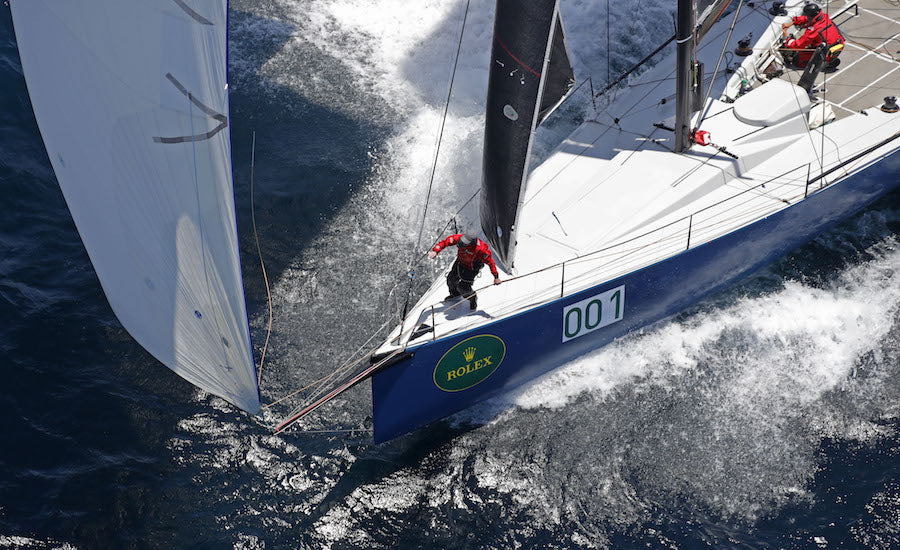SPEED READING : OFFSHORE RACING
SPEED READING : OFFSHORE RACING
North Sails Billy Sykes shares tips for racing offshore long distance

Billy Sykes joined Matt Allen for the 2017 Sydney-Hobart. Matt won this race 34 years ago, and just last year pulled off the overall corrected time win, where he was awarded the prestigious Tattersall Trophy. Over the course of the race, there were lessons learned but the overall experience was something the skipper and crew had well-prepared for. Billy shares his top five tips for doing a long distance offshore race based off his latest experience on the new TP52 Ichi Ban.
Build your team with intent.
Each crew member wears multiple hats. Going into a distance race, there will be times where the crew has to get some rest. Usually the crew will divide into shifts or groups to make this possible. While some of the crew is resting down below, the others are racing the boat to its full potential. During this time, you wouldn’t wake up your crew to come out on deck for a sail change, you’d simply execute it with the crew that was ondeck for that shift. Building your team with intent to let everyone take turns for each job is the reality of a long distance offshore race. There isn’t just one bowman. There isn’t just one kite trimmer. Having each crew member understand all positions, it makes the team stronger and contributes to the team’s overall success.

Make sure your crew is comfortable and confident at the helm.
For an offshore race, it is crucial that all crew members can steer the boat with confidence. In our case during the Sydney-Hobart, Matt made sure all the trimmers were happy steering the boat so by the time we started the race, we all felt we knew the boat well. Over half the crew ended up helming over the course of the race so this preparation was critical. In big breeze downwind with the our biggest masthead spinnaker up, being able to change who was at the helm every hour was a fundamental piece of the success – everyone on our crew knew what to do so they were quick to make decisions and comfortable executing maneuvers.
“Matt did a great job making sure all crew members could steer with confidence during the Sydney-Hobart. It was very challenging to steer the boat downwind in these conditions. The best for us was that we just kept pushing her hard, we never took the pedal off. Running at 24-30 knots with essentially our biggest masthead spinnaker up was so challenging, it was two stand-out helmsman in those conditions
who took the tiller and did an exceptional job.”
Choose your inventory wisely.
During the Rolex Sydney-Hobart Race the sea-state was tremendous. Going into the race you have an idea of what to expect, and after do-diligence, you can be more assured you know what you need to get you to the finish line. Accounting for the wind directions, weather systems, and points of sail that you will likely be on helps determine what you want to have on hand. For most offshore racing, the navigators will try to get the boat into the best current that would lead you in the right direction of the mark. Sometimes however, that doesn’t help the sea-state factor you will experience, which can be bad and unavoidable in some cases making the sail choices, and range of each sail even more important.
“Ichi Ban’s main took an absolute beating during the Sydney-Hobart last year. The sail was still perfectly fine, holding up to that type of wind pressure with no problems definitely shows what an exceptional product 3Di is.”

Know your inventory and know how each sail works.
Knowing what sails you have onboard, and when to use them is of most importance. Always keep in mind you may need one in a pinch. Choosing sails is like deciding tactics. Depending on what you have onboard that you can put up also dictates what sort of tactical maneuvers are possible with your given sail choice. Another part to this is that good sail management and some well-timed eases on the kite sheet prevented damage to our sails.
“We all talked about the sail options we were going to bring a few nights before the start. We talked about combinations and racing style and what was going to work best. Essentially, I wouldn’t change anything that we took when we left Sydney Harbour.”
Having an owner who sets expectations and is hands-on during the planning process.
Having a confident owner is very important. Matt was very involved in choosing his sail inventory before the race. He knew what he wanted and that helped our team aid him in getting the right sails for the boat. Matt was there every step of the way to make sure we constructed the headsails and spinnakers out of the strongest materials possible so his inventory could handle a wider wind range. Our entire team here in Sydney worked hand-in-hand with Matt on this; the mainsail, headsail, and the spinnakers. We especially took some time to consider what DPI we were going to use for each upwind sail. Matt knew what he wanted, knew what he needed, and we were there to help him get exactly that.
“The planning, thought, and research that Matt and the team did before the build even started made Ichi Ban the race winning boat it is today.”
For the Sydney-Hobart race, Ichi Ban was equipped upwind with 3Di RAW 870 offshore mainsail, J2.5 3Di RAW 870, J4 3Di 870 ENDURANCE, 3Di RAW 760 FRO. Downwind she had the options of A2+. A3. A4, and A6. She also had a genoa staysail, made of 3Di RAW 870, and a spinnaker staysail.
Ichi Ban‘s most frequently used sail was the A4 and genoa staysail. Her fastest speed recorded was 26 knots with an average speed of 16 knots.




























